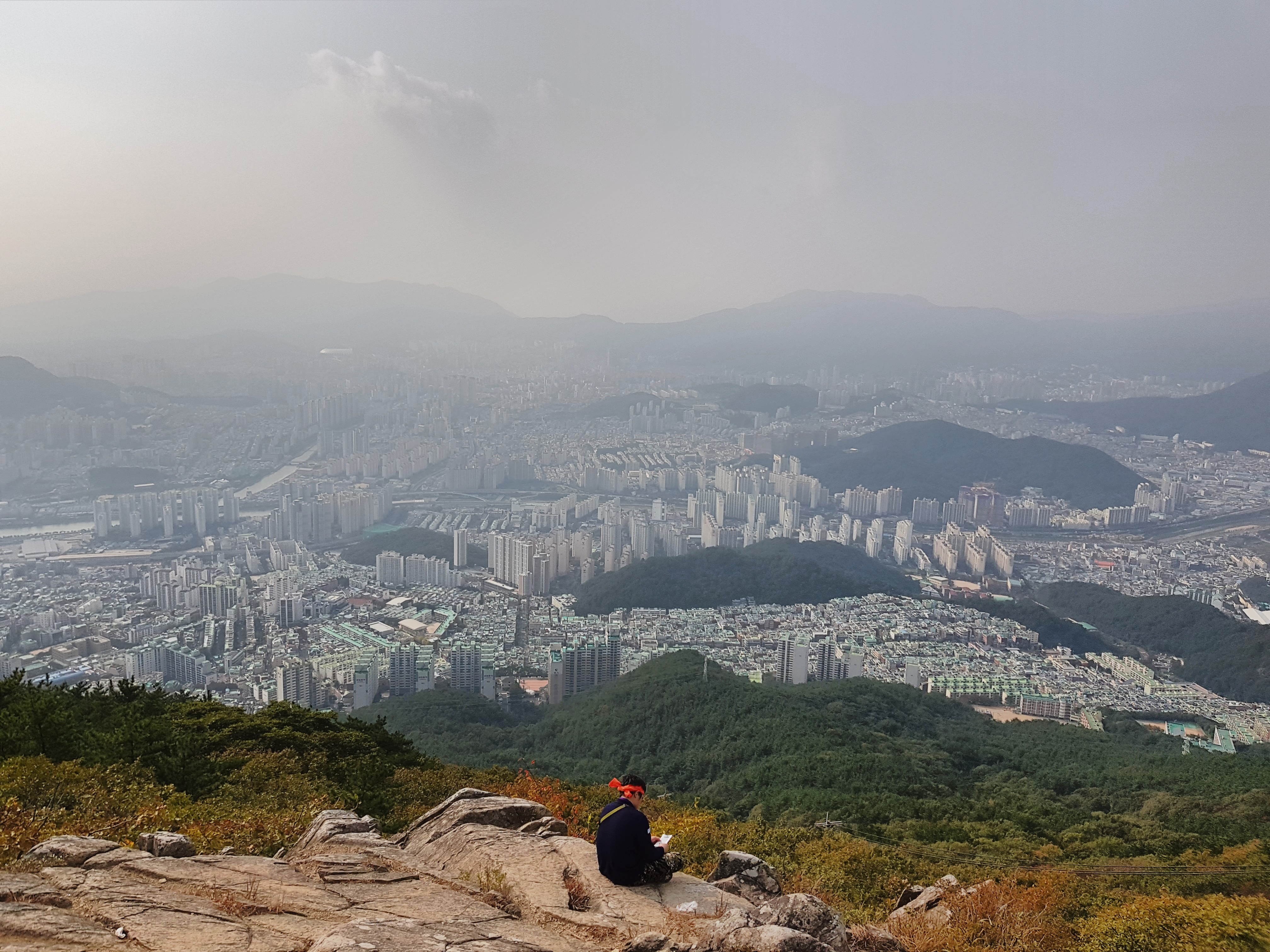Jangsan summit in Busan – South Korea 2018
Jangsan Mountain is a prominent and scenic mountain located in Busan, South Korea. With its towering peak, lush forests, and stunning views, Jangsan Mountain is a popular destination for both locals and tourists, and it is widely considered one of the city’s most iconic natural landmarks.
Jangsan Mountain stands at approximately 368 meters tall, and its steep, rocky slopes are covered in dense forests of pine and deciduous trees. The mountain is located on the western side of Busan, and it provides a dramatic backdrop to the city, as well as stunning views of the surrounding landscapes and the nearby coast.
One of the most popular attractions on Jangsan Mountain is the Jangsan Seongmu Park, which is a large, well-maintained park that offers visitors a chance to experience the mountain’s natural beauty and enjoy a range of outdoor activities. The park features several hiking trails, picnic areas, and scenic lookouts, and it is a popular destination for families, hikers, and nature lovers.
In addition to its natural beauty, Jangsan Mountain is also known for its rich cultural and historical heritage. The mountain is home to several historic temples, including the Jangsan Temple and the Danggam Temple, which are popular destinations for tourists and pilgrimage. These temples are important cultural and religious landmarks, and they offer a glimpse into the rich spiritual and cultural heritage of the region.
Another popular attraction on Jangsan Mountain is the Jangsan Tower, which is a tall observation tower that provides visitors with panoramic views of the city and the surrounding landscapes. The tower is a popular spot for sightseeing and photography, and it is a great place to take in the mountain’s breathtaking views.
In conclusion, Jangsan Mountain is a magnificent and iconic mountain that is a must-visit destination for anyone visiting Busan. With its lush forests, stunning views, and rich cultural and historical heritage, Jangsan Mountain is a true gem in the heart of the city, and it offers visitors a unique and unforgettable experience. Whether you’re interested in hiking, sightseeing, or simply taking in the natural beauty of the area, Jangsan Mountain is a destination that is not to be missed.
History
Jangsan Mountain is a landmark mountain located in Busan, South Korea, and it has a rich and fascinating history that spans thousands of years. From its earliest days as a spiritual and cultural center, to its role as a site of military conflict and industrial development, Jangsan Mountain has played an important role in the city’s history and development.
The earliest recorded history of Jangsan Mountain dates back to the Three Kingdoms period (57 BCE – 668 CE), when the mountain was considered a spiritual and cultural center. During this time, several temples and shrines were built on the mountain, and it was considered an important place of pilgrimage. One of the most notable temples on Jangsan Mountain was the Jangsan Temple, which was founded during the Three Kingdoms period and is still standing today.
In the centuries that followed, Jangsan Mountain continued to play an important role in the region’s cultural and spiritual life. During the Goryeo Dynasty (918-1392), the mountain was a center of Buddhism, and several temples and monasteries were established on its slopes. During this time, Jangsan Mountain was also a popular destination for artists and intellectuals, who were drawn to its scenic beauty and cultural heritage.
In the modern era, Jangsan Mountain played an important role in the city’s development and growth. During the late 19th and early 20th centuries, Busan was undergoing rapid industrialization, and Jangsan Mountain was the site of several major industrial developments. The mountain was the site of several coal mines, and its forests were cleared to make way for new industrial and residential developments.
However, Jangsan Mountain also played a role in the darker moments of Busan’s history. During the Korean War (1950-1953), the mountain was the site of several battles between North Korean and South Korean forces, and it was also used as a staging area for military operations.
Today, Jangsan Mountain is a popular destination for visitors to Busan, and it has been preserved and protected as a natural and cultural heritage site. The mountain is home to several parks and nature reserves, as well as several historic temples and shrines. It is widely considered one of the city’s most iconic landmarks, and it attracts thousands of visitors each year.
In conclusion, Jangsan Mountain is a landmark mountain with a rich and fascinating history that spans thousands of years. From its earliest days as a spiritual and cultural center, to its role as a site of military conflict and industrial development, Jangsan Mountain has played an important role in the city’s history and development, and it continues to be an important and beloved part of Busan’s cultural and natural heritage.
Geology
Jangsan Mountain is a unique and geologically significant landmark located in the city of Busan, South Korea. The mountain is composed of a variety of rock formations, including granite, gneiss, and schist, and it provides a fascinating window into the geological history of the region.
One of the most notable features of Jangsan Mountain is its granite formations, which are some of the oldest rocks in the region and date back to the Precambrian Era (approximately 4 billion years ago). These granite formations are some of the best examples of Precambrian-era rocks in South Korea, and they provide valuable information about the region’s geological history and evolution.
Another notable aspect of Jangsan Mountain’s geology is its gneiss formations, which are metamorphic rocks that have been altered by heat and pressure over millions of years. These gneiss formations are some of the oldest rocks in the region and provide valuable information about the geological forces that shaped the region over time.
The schist formations on Jangsan Mountain are also of geological significance, as they are part of the Jangsan Schist Belt, a geologic formation that runs along the southeastern coast of South Korea. These schist formations were formed over hundreds of millions of years as the result of tectonic activity and the collision of two ancient land masses.
In addition to its rock formations, Jangsan Mountain is also home to several unique geological features, such as valleys, waterfalls, and caves. These features are the result of millions of years of erosion and weathering, and they provide an opportunity to explore the dynamic geological processes that have shaped the region over time.
Today, Jangsan Mountain is protected as a natural heritage site, and its geology is a popular subject of study and research. Geologists, geology students, and outdoor enthusiasts alike are drawn to the mountain for its unique rock formations, geological features, and breathtaking landscapes.
Jangsan Mountain is a unique and geologically significant landmark located in Busan, South Korea. From its ancient granite formations to its gneiss and schist formations, Jangsan Mountain provides a fascinating window into the geological history of the region and offers a wealth of opportunities for exploration and study.

